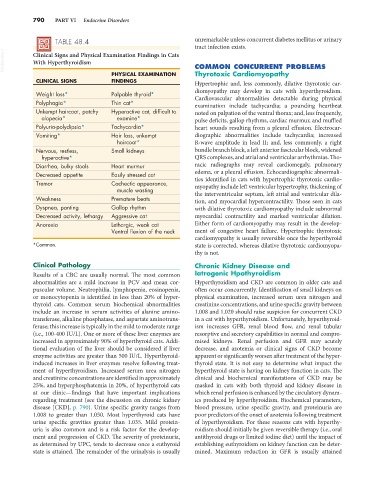Page 818 - Small Animal Internal Medicine, 6th Edition
P. 818
790 PART VI Endocrine Disorders
TABLE 48.4 unremarkable unless concurrent diabetes mellitus or urinary
tract infection exists.
VetBooks.ir Clinical Signs and Physical Examination Findings in Cats COMMON CONCURRENT PROBLEMS
With Hyperthyroidism
PHYSICAL EXAMINATION Thyrotoxic Cardiomyopathy
CLINICAL SIGNS FINDINGS Hypertrophic and, less commonly, dilative thyrotoxic car-
diomyopathy may develop in cats with hyperthyroidism.
Weight loss* Palpable thyroid* Cardiovascular abnormalities detectable during physical
Polyphagia* Thin cat* examination include tachycardia; a pounding heartbeat
Unkempt haircoat, patchy Hyperactive cat, difficult to noted on palpation of the ventral thorax; and, less frequently,
alopecia* examine* pulse deficits, gallop rhythms, cardiac murmur, and muffled
Polyuria-polydipsia* Tachycardia* heart sounds resulting from a pleural effusion. Electrocar-
Vomiting* Hair loss, unkempt diographic abnormalities include tachycardia; increased
haircoat* R-wave amplitude in lead II; and, less commonly, a right
Nervous, restless, Small kidneys bundle branch block, a left anterior fascicular block, widened
hyperactive* QRS complexes, and atrial and ventricular arrhythmias. Tho-
Diarrhea, bulky stools Heart murmur racic radiographs may reveal cardiomegaly, pulmonary
Decreased appetite Easily stressed cat edema, or a pleural effusion. Echocardiographic abnormali-
Tremor Cachectic appearance, ties identified in cats with hypertrophic thyrotoxic cardio-
myopathy include left ventricular hypertrophy, thickening of
muscle wasting the interventricular septum, left atrial and ventricular dila-
Weakness Premature beats tion, and myocardial hypercontractility. Those seen in cats
Dyspnea, panting Gallop rhythm with dilative thyrotoxic cardiomyopathy include subnormal
Decreased activity, lethargy Aggressive cat myocardial contractility and marked ventricular dilation.
Anorexia Lethargic, weak cat Either form of cardiomyopathy may result in the develop-
Ventral flexion of the neck ment of congestive heart failure. Hypertrophic thyrotoxic
cardiomyopathy is usually reversible once the hyperthyroid
*Common. state is corrected, whereas dilative thyrotoxic cardiomyopa-
thy is not.
Clinical Pathology Chronic Kidney Disease and
Results of a CBC are usually normal. The most common Iatrogenic Hpothyroidism
abnormalities are a mild increase in PCV and mean cor- Hyperthyroidism and CKD are common in older cats and
puscular volume. Neutrophilia, lymphopenia, eosinopenia, often occur concurrently. Identification of small kidneys on
or monocytopenia is identified in less than 20% of hyper- physical examination, increased serum urea nitrogen and
thyroid cats. Common serum biochemical abnormalities creatinine concentrations, and urine specific gravity between
include an increase in serum activities of alanine amino- 1.008 and 1.020 should raise suspicion for concurrent CKD
transferase, alkaline phosphatase, and aspartate aminotrans- in a cat with hyperthyroidism. Unfortunately, hyperthyroid-
ferase; this increase is typically in the mild to moderate range ism increases GFR, renal blood flow, and renal tubular
(i.e., 100-400 IU/L). One or more of these liver enzymes are resorptive and secretory capabilities in normal and compro-
increased in approximately 90% of hyperthyroid cats. Addi- mised kidneys. Renal perfusion and GFR may acutely
tional evaluation of the liver should be considered if liver decrease, and azotemia or clinical signs of CKD become
enzyme activities are greater than 500 IU/L. Hyperthyroid- apparent or significantly worsen after treatment of the hyper-
induced increases in liver enzymes resolve following treat- thyroid state. It is not easy to determine what impact the
ment of hyperthyroidism. Increased serum urea nitrogen hyperthyroid state is having on kidney function in cats. The
and creatinine concentrations are identified in approximately clinical and biochemical manifestations of CKD may be
25%, and hyperphosphatemia in 20%, of hyperthyroid cats masked in cats with both thyroid and kidney disease in
at our clinic—findings that have important implications which renal perfusion is enhanced by the circulatory dynam-
regarding treatment (see the discussion on chronic kidney ics produced by hyperthyroidism. Biochemical parameters,
disease [CKD], p. 790). Urine specific gravity ranges from blood pressure, urine specific gravity, and proteinuria are
1.008 to greater than 1.050. Most hyperthyroid cats have poor predictors of the onset of azotemia following treatment
urine specific gravities greater than 1.035. Mild protein- of hyperthyroidism. For these reasons cats with hyperthy-
uria is also common and is a risk factor for the develop- roidism should initially be given reversible therapy (i.e., oral
ment and progression of CKD. The severity of proteinuria, antithyroid drugs or limited iodine diet) until the impact of
as determined by UPC, tends to decrease once a euthyroid establishing euthyroidism on kidney function can be deter-
state is attained. The remainder of the urinalysis is usually mined. Maximum reduction in GFR is usually attained

